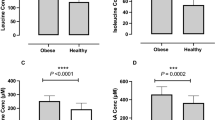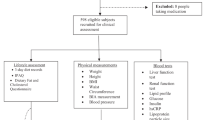Abstract
Background/Objectives:
Consumption of n−3 polyunsaturated fatty acids (PUFA) has a favourable impact on inflammation and cardiovascular disease. However, the Western diet is characterized by a low n−3 PUFA intake and an imbalance in the n−6/n−3 PUFA ratio. Study the effect 10-week of diet modification to decrease the n−6/n−3 PUFA ratio on cardiovascular risk factors and resting energy expenditure.
Subjects and methods:
Ten-week dietary intervention in 17 healthy subjects. Dietary intake, euglycemic hyperinsulinemic clamp, indirect calorimetry, lipid profile, hormones, inflammatory markers and erythrocyte membrane fatty acid composition were recorded before and at the end of the intervention. Comparisons are between baseline and post-treatment levels.
Results:
Dietary records of the linoleic acid/α-linolenic acid ratio (baseline: 32.2 (s.d. 3.7) vs post-intervention: 2.2 (s.d. 0.1), P<0.0001) and erythrocyte membrane fatty acid composition reflected good compliance. Dietary intervention was associated with significant reductions in TNF-α (baseline: 2.2 (s.d. 0.3), post-intervention: 1.5 (s.d. 0.3) pg/ml, P=0.01) and low-density lipoprotein-cholesterol (baseline: 2.5 (s.d. 0.2), post-intervention: 2.3 (s.d. 0.1) mmol/l, P=0.03) and increased adiponectin (baseline: 6.5 (s.d. 0.7), post-intervention: 7.6 (s.d. 0.6) μg/ml, P=0.02). Fasting lipid oxidation was increased (baseline: 0.7 (s.d. 0.1), post-intervention: 0.9 (s.d. 0.1) mg/kg.min, P=0.01), whereas glucose oxidation decreased in both fasting (baseline: 1.6 (s.d. 0.1), post-intervention: 1.3 (s.d. 0.1) mg/kg.min, P=0.02) and hyperinsulinaemic conditions (baseline: 3.6 (s.d. 0.1), post-intervention: 3.3 (s.d. 0.1) mg/kg.min, P=0.04). Insulin sensitivity was not affected by the intervention.
Conclusion:
A decreased n−6/n−3 PUFA ratio can be achieved with simple dietary counselling, resulting in multiple, potentially favourable effects on the metabolic and inflammatory profiles.
This is a preview of subscription content, access via your institution
Access options
Subscribe to this journal
Receive 12 print issues and online access
$259.00 per year
only $21.58 per issue
Buy this article
- Purchase on Springer Link
- Instant access to full article PDF
Prices may be subject to local taxes which are calculated during checkout

Similar content being viewed by others
References
Albert CM, Campos H, Stampfer MJ, Ridker PM, Manson JE, Willett WC et al. (2002). Blood levels of long-chain n−3 fatty acids and the risk of sudden death. N Engl J Med 346, 1113–1118.
Baker PW, Gibbons GF (2000). Effect of dietary fish oil on the sensitivity of hepatic lipid metabolism to regulation by insulin. J Lipid Res 41, 719–726.
Bligh EG, Dyer WJ (1959). A rapid method of total lipid extraction and purification. Can J Biochem Physiol 37, 911–917.
Caughey GE, Mantzioris E, Gibson RA, Cleland LG, James MJ (1996). The effect on human tumor necrosis factor alpha and interleukin 1 beta production of diets enriched in n−3 fatty acids from vegetable oil or fish oil. Am J Clin Nutr 63, 116–122.
Clarke SD (2001). Polyunsaturated fatty acid regulation of gene transcription: a molecular mechanism to improve the metabolic syndrome. J Nutr 131, 1129–1132.
Connor WE (2000). Importance of n−3 fatty acids in health and disease. Am J Clin Nutr 71, 171S–175S.
Couet C, Delarue J, Ritz P, Antoine JM, Lamisse F (1997). Effect of dietary fish oil on body fat mass and basal fat oxidation in healthy adults. Int J Obes Relat Metab Disord 21, 637–643.
de Lorgeril M, Salen P, Martin JL, Monjaud I, Delaye J, Mamelle N (1999). Mediterranean diet, traditional risk factors, and the rate of cardiovascular complications after myocardial infarction: final report of the Lyon Diet Heart Study. Circulation 99, 779–785.
Deharveng G, Charrondiere UR, Slimani N, Southgate DA, Riboli E (1999). Comparison of nutrients in the food composition tables available in the nine European countries participating in EPIC. European prospective investigation into cancer and nutrition. Eur J Clin Nutr 53, 60–79.
Delarue J, LeFoll C, Corporeau C, Lucas D (2004). n−3 long chain polyunsaturated fatty acids: a nutritional tool to prevent insulin resistance associated to type 2 diabetes and obesity? Reprod Nutr Dev 44, 289–299.
Ducluzeau PH, Perretti N, Laville M, Andreelli F, Vega N, Riou JP et al. (2001). Regulation by insulin of gene expression in human skeletal muscle and adipose tissue. Evidence for specific defects in type 2 diabetes. Diabetes 50, 1134–1142.
Endres S, Ghorbani R, Kelley VE, Georgilis K, Lonnemann G, van der Meer JW et al. (1989). The effect of dietary supplementation with n−3 polyunsaturated fatty acids on the synthesis of interleukin-1 and tumor necrosis factor by mononuclear cells. N Engl J Med 320, 265–271.
Engeli S, Feldpausch M, Gorzelniak K, Hartwig F, Heintze U, Janke J et al. (2003). Association between adiponectin and mediators of inflammation in obese women. Diabetes 52, 942–947.
Flachs P, Mohamed-Ali V, Horakova O, Rossmeisl M, Hosseinzadeh-Attar MJ, Hensler M et al. (2006). Polyunsaturated fatty acids of marine origin induce adiponectin in mice fed a high-fat diet. Diabetologia 49, 394–397.
Friberg P, Johansson M (2007). Effects of an omega-3-enriched Mediterranean diet (modified diet of Crete) versus a Swedish diet. World Rev Nutr Diet 97, 52–66.
Gerster H (1998). Can adults adequately convert alpha-linolenic acid (18:3n−3) to eicosapentaenoic acid (20:5n−3) and docosahexaenoic acid (22:6n−3)? Int J Vitam Nutr Res 68, 159–173.
GISSI-Prevenzione-Investigators (1999). Dietary supplementation with n−3 polyunsaturated fatty acids and vitamin E after myocardial infarction: results of the GISSI-Prevenzione trial. Gruppo Italiano per lo Studio della Sopravvivenza nell'Infarto miocardico. Lancet 354, 447–455.
Halvorsen B, Rustan AC, Madsen L, Reseland J, Berge RK, Sletnes P et al. (2001). Effects of long-chain monounsaturated and n−3 fatty acids on fatty acid oxidation and lipid composition in rats. Ann Nutr Metab 45, 30–37.
He K, Daviglus ML (2005). A few more thoughts about fish and fish oil. J Am Diet Assoc 105, 350–351.
Hooper L, Thompson RL, Harrison RA, Summerbell CD, Ness AR, Moore HJ et al. (2006). Risks and benefits of omega 3 fats for mortality, cardiovascular disease, and cancer: systematic review. BMJ 332, 752–760.
Iso H, Kobayashi M, Ishihara J, Sasaki S, Okada K, Kita Y et al. (2006). Intake of fish and n3 fatty acids and risk of coronary heart disease among Japanese: the Japan public health center-based (JPHC) study cohort I. Circulation 113, 195–202.
Jump DB, Clarke SD (1999). Regulation of gene expression by dietary fat. Annu Rev Nutr 19, 63–90.
Kern PA, Di Gregorio GB, Lu T, Rassouli N, Ranganathan G (2003). Adiponectin expression from human adipose tissue: relation to obesity, insulin resistance, and tumor necrosis factor-alpha expression. Diabetes 52, 1779–1785.
Krauss RM, Eckel RH, Howard B, Appel LJ, Daniels SR, Deckelbaum RJ et al. (2000). AHA dietary guidelines: revision 2000: a statement for healthcare professionals from the nutrition committee of the American heart association. Circulation 102, 2284–2299.
Kris-Etherton PM, Taylor DS, Yu-Poth S, Huth P, Moriarty K, Fishell V et al. (2000). Polyunsaturated fatty acids in the food chain in the United States. Am J Clin Nutr 71, 179S–188S.
Kris-Etherton PM, Harris WS, Appel LJ (2002). Fish consumption, fish oil, omega-3 fatty acids, and cardiovascular disease. Circulation 106, 2747–2757.
Laville M, Rigalleau V, Riou JP, Beylot M (1995). Respective role of plasma nonesterified fatty acid oxidation and total lipid oxidation in lipid-induced insulin resistance. Metabolism 44, 639–644.
Lombardo YB, Chicco AG (2006). Effects of dietary polyunsaturated n−3 fatty acids on dyslipidemia and insulin resistance in rodents and humans: a review. J Nutr Biochem 17, 1–13.
Meydani SN, Endres S, Woods MM, Goldin BR, Soo C, Morrill-Labrode A et al. (1991). Oral (n−3) fatty acid supplementation suppresses cytokine production and lymphocyte proliferation: comparison between young and older women. J Nutr 121, 547–555.
Neschen S, Morino K, Rossbacher JC, Pongratz RL, Cline GW, Sono S et al. (2006). Fish oil regulates adiponectin secretion by a peroxisome proliferator-activated receptor-gamma-dependent mechanism in mice. Diabetes 55, 924–928.
Nettleton JA, Katz R (2005). n−3 Long-chain polyunsaturated fatty acids in type 2 diabetes: a review. J Am Diet Assoc 105, 428–440.
Pai JK, Pischon T, Ma J, Manson JE, Hankinson SE, Joshipura K et al. (2004). Inflammatory markers and the risk of coronary heart disease in men and women. N Engl J Med 351, 2599–2610.
Rabasa-Lhoret R, Bastard JP, Jan V, Ducluzeau PH, Andreelli F, Guebre F et al. (2003). Modified quantitative insulin sensitivity check index is better correlated to hyperinsulinemic glucose clamp than other fasting-based index of insulin sensitivity in different insulin-resistant states. J Clin Endocrinol Metab 88, 4917–4923.
Rivellese AA, Lilli S (2003). Quality of dietary fatty acids, insulin sensitivity and type 2 diabetes. Biomed Pharmacother 57, 84–87.
Rossi AS, Lombardo YB, Lacorte JM, Chicco AG, Rouault C, Slama G et al. (2005). Dietary fish oil positively regulates plasma leptin and adiponectin levels in sucrose-fed, insulin-resistant rats. Am J Physiol Regul Integr Comp Physiol 289, R486–R494.
Simopoulos AP (1999). Essential fatty acids in health and chronic disease. Am J Clin Nutr 70, 560S–569S.
Simopoulos AP, Robinson J (1999). The Omega Diet. The Lifesaving Nutritional Program Based on the Diet of the Island of Crete. HarperCollins: New York.
Skilton MR, Celermajer DS (2006). The effects of obesity-related peptides on the vasculature. Curr Vasc Pharmacol 4, 79–85.
Summers LK, Fielding BA, Bradshaw HA, Ilic V, Beysen C, Clark ML et al. (2002). Substituting dietary saturated fat with polyunsaturated fat changes abdominal fat distribution and improves insulin sensitivity. Diabetologia 45, 369–377.
Ukropec J, Reseland JE, Gasperikova D, Demcakova E, Madsen L, Berge RK et al. (2003). The hypotriglyceridemic effect of dietary n−3 FA is associated with increased beta-oxidation and reduced leptin expression. Lipids 38, 1023–1029.
Weyer C, Funahashi T, Tanaka S, Hotta K, Matsuzawa Y, Pratley RE et al. (2001). Hypoadiponectinemia in obesity and type 2 diabetes: close association with insulin resistance and hyperinsulinemia. J Clin Endocrinol Metab 86, 1930–1935.
Wigmore SJ, Fearon KC, Maingay JP, Ross JA (1997). Down-regulation of the acute-phase response in patients with pancreatic cancer cachexia receiving oral eicosapentaenoic acid is mediated via suppression of interleukin−6. Clin Sci (Lond) 92, 215–221.
Yamauchi T, Kamon J, Minokoshi Y, Ito Y, Waki H, Uchida S et al. (2002). Adiponectin stimulates glucose utilization and fatty-acid oxidation by activating AMP-activated protein kinase. Nat Med 8, 1288–1295.
Acknowledgements
We thank Monique Sothier, Christine Maitrepierre, Jocelyne Peyrat and Corine Louche-Pellissier for their contribution to this work. We thank Beckman-Coulter France for the generous gift of antibodies for Hs-CRP measurement as well as P Chaumon and Centre d'éducation, recherche et information en nutrition (CERIN) for financial support and advice. This work was supported by a grant from Association de langue française pour l'étude du diabète et autre maladies métaboliques (ALFEDIAM-Servier) and Fondation pour la Recherche Médicale, France.
The editorial assistance of Ovid M Da Silva, Research Support Office, Research Centre, CHUM is also acknowledged.
Author information
Authors and Affiliations
Corresponding author
Additional information
Contributors: FG-E: Data collection/interpretation and manuscript. RR-L: Data collection/interpretation and manuscript. FB: Manuscript. J-PB: Data collection and manuscript revision. MD: Data collection and manuscript revision. MRS: Manuscript revision. HV: Study design and manuscript revision. ML: Study design and supervision, and manuscript revision.
Rights and permissions
About this article
Cite this article
Guebre-Egziabher, F., Rabasa-Lhoret, R., Bonnet, F. et al. Nutritional intervention to reduce the n−6/n−3 fatty acid ratio increases adiponectin concentration and fatty acid oxidation in healthy subjects. Eur J Clin Nutr 62, 1287–1293 (2008). https://doi.org/10.1038/sj.ejcn.1602857
Received:
Revised:
Accepted:
Published:
Issue Date:
DOI: https://doi.org/10.1038/sj.ejcn.1602857
Keywords
This article is cited by
-
Effects of low doses of fish and milk proteins on glucose regulation and markers of insulin sensitivity in overweight adults: a randomised, double blind study
European Journal of Nutrition (2020)
-
A prospective study of erythrocyte polyunsaturated fatty acid, weight gain, and risk of becoming overweight or obese in middle-aged and older women
European Journal of Nutrition (2016)
-
N‐3 Polyunsaturated Fatty Acids: Relationship to Inflammation in Healthy Adults and Adults Exhibiting Features of Metabolic Syndrome
Lipids (2013)
-
Chronic inflammatory diseases are stimulated by current lifestyle: how diet, stress levels and medication prevent our body from recovering
Nutrition & Metabolism (2012)
-
Relationship between red cell membrane fatty acids and adipokines in individuals with varying insulin sensitivity
European Journal of Clinical Nutrition (2011)



